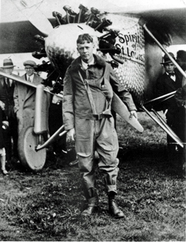 On May 20, 1927, Charles Lindbergh took off from Roosevelt Airfield on Long Island, New York, aboard the Spirit of St. Louis, the custom-built, single engine, single-seat monoplane, on his historic solo flight to France. 33 hours, 30 minutes later he landed at Aéroport Le Bourget in Paris, France, a distance of about 3,600 miles. 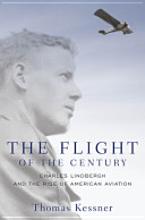 Read more about it: The Flight of the Century (Thomas Kessner, 2010) In 1927 an inexperienced and humble 25-year-old Air Mail pilot from Minnesota stunned the world by making the first non-stop transatlantic flight. A spectacular triumph of individual daring and collective technological accomplishment, Charles Lindbergh's flight from New York to Paris ushered in the age of commercial aviation. Kessner takes a look at one of America's greatest moments, examining how what was essentially a publicity stunt became a turning point in history. He vividly recreates the flight itself and the euphoria that greeted the achievement on both sides of the Atlantic. He makes the case that Lindbergh's feat occurred just when the world--still struggling with the disillusionment of WWI--desperately needed a hero to restore a sense of optimism and possibility. 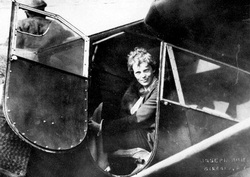 Just five years later, on May 20, 1932, Amelia Earhart took off from Harbor Grace, Newfoundland in her Lockheed Vega nicknamed "Little Red Bus," on her flight to Paris, hoping to duplicate Lindbergh's achievement and become the first woman to fly solo across the Atlantic Ocean. Strong north winds pushed her off course, and icy conditions and mechanical problems plagued the flight, forcing her to land in a pasture near Londonderry, Ireland. But she had indeed crossed the Atlantic.  Read more about it: Amelia Earhart: The Thrill of It (Susan Wels, 2009) America’s record-breaking aviatrix pursued her passions, broke gender barriers, and inspired generations of women to take to the skies. Wels writes a brisk narrative which hits all the main points and captures the can-do spirit of Earhart. 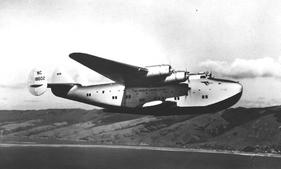 Boeing 314 - California Clipper (courtesy aviationhistory.com) Seven years later, on May 20, 1939, Pan American Airways inaugurated the first transatlantic mail service. Under the command of Captain A. E. LaPorte, a Boeing 314 Clipper carried almost a ton of mail from Port Washington to Marseilles, via the Azores and Lisbon in 29 hours. 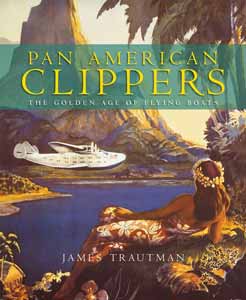 Read more about it: Pan American Clippers: The Golden Age of Flying Boats ( James Trautman, 2011) For the world struggling to emerge from the economic turmoil of the 1930s, the Pan American Airways Clipper "flying boats" symbolized elegance, adventure and romance. This fascinating book, illustrated with photographs, travel posters, magazine ads and company brochures, brings to life every aspect of the fabulous era of Pan American's clippers. Like their sea-going namesakes, Clippers used the oceans to form a global network of travel routes. Pan Am founder Juan Trippe envisioned the importance of international travel to a changing world. His Clippers played a key role in the evolution of transoceanic flight, setting time and distance records over the Atlantic and Pacific, providing airmail delivery between continents and eventually serving the Allies as troop and cargo transports during World War II. High Flight
Oh! I have slipped the surly bonds of earth, And danced the skies on laughter-silvered wings; Sunward I've climbed, and joined the tumbling mirth Of sun-split clouds, --and done a hundred things You have not dreamed of --Wheeled and soared and swung High in the sunlit silence. Hov'ring there I've chased the shouting wind along, and flung My eager craft through footless halls of air... Up, up the long, delirious, burning blue I've topped the wind-swept heights with easy grace Where never lark or even eagle flew -- And, while with silent lifting mind I've trod The high untrespassed sanctity of space, Put out my hand, and touched the face of God. --- John Gillespie Magee, Jr.
0 Comments
Leave a Reply. |
AuthorTo find out more about me, click on the Not Your Average Jo tab. Archives
February 2024
Categories
All
|
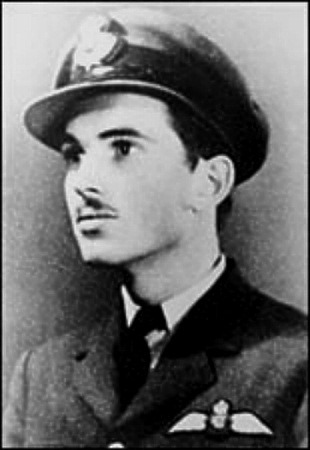
 RSS Feed
RSS Feed